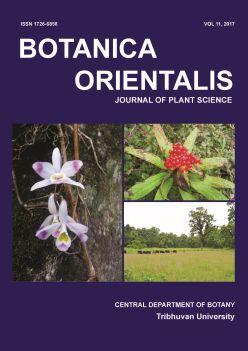Floodplain succession pattern along Budhi-Rapti River bank, Chitwan, Nepal
DOI:
https://doi.org/10.3126/botor.v11i0.21027Keywords:
Chronosequence, Convergence, NMDS, Primary succession, RDA, Spatio-temporal, Species richnessAbstract
Riverine floodplain is one of the most productive lowland ecosystems in Nepal. However, floodplain ecology is less understood due to its fluctuation. Budhi-Rapti River in Chitwan, central Nepal formed a floodplain along the Khorsor zone of Barandabhar corridor. This study was carried out to understand the floodplain ecosystem development after plant succession. The space for time substitution method of vegetation sampling was adopted in order to sample the floodplain created at different chronosequence. The floodplain that lies perpendicular to and 200 m away from the Budhi-Rapti river was sampled. Systematic sampling was done along two parallel transects, almost 200 m apart from each other. Sampling along the transect started right after 200 m away from the Budhi-River bank. Initial position of these transects towards Budhi-Rapti river was believed to be the youngest floodplain, which slowly getting older after passing away from the river. Abundance of vascular plant species was recorded in sample plots of 20 × 20 m each subdivided equally into 4 subplots (each of 100 m2). Along each transect, vegetation data was recorded from a series of 20 plots, placed 50 m apart from each other. Successional scores were calculated and utilized as environmental variables after applying non-metric multi-dimensional scaling (NMDS) through metaMDS. Total and life form (herbs, shrubs and trees) richness patterns were calculated. Altogether, 158 species of vascular plants under 60 families and 136 genera were recorded. Gramineae was the richest family followed by Leguminosae, Asteraceae and Cyperaceae. Total species richness showed significant negative correlation with the NMDS1 and NMDS2, which justified a convergent pattern of succession. Herb, orchid and shrub species richness also showed significant declining pattern with NMDS1. Persicaria barbata, Parthenium hysterophorus, Ageratum conyzoides and Typha angustifolia were early succession indicator species; whereas Albizia lucidior, Miliusa velutina, Ficus hispida, Bauhinia purpurea and Brassaiopsis glomerulata were the late succession tree species. This study agreed with the convergent model of succession.
Botanica Orientalis – Journal of Plant Science (2017) 11: 12–26
Downloads
Downloads
Published
How to Cite
Issue
Section
License
This license enables reusers to copy and distribute the material in any medium or format in unadapted form only, for noncommercial purposes only, and only so long as attribution is given to the creator.




